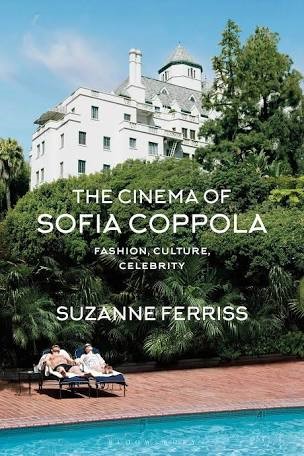In 1982, feminist film theorist Mary Ann Doane wrote, “the cinema is characterised by an illusory sensory plenitude (there is ‘so much to see’) and yet haunted by the absence of those very objects which are there to be seen.”1 In her latest work, Suzanne Ferriss attempts to reinforce the predominance of fashion throughout the works of contemporary auteur Sofia Coppola. Uprooted from the frivolous and feminized stigma of fashion as clothing, Ferriss redirects the reader to understand fashion as broad aesthetic practice, as self-fabrication, and as a marker of change without gendered bias. In this altered context, Ferriss demonstrates how Coppola artfully transforms style itself into substance, engaging with plentitude as a means to inform the audience of “the sensory pleasures (and dangers) of consumption.”2
Presented as a comprehensive analysis of Coppola’s oeuvre, Ferriss’ discussion hinges on the director’s feature films—The Virgin Suicides (1999), Lost in Translation (2003), Marie Antoinette (2006), The Bling Ring (2013), Somewhere (2010), The Beguiled (2017)—as well as her short film, Lick the Star (1998), music videos and commercial work for major fashion designers. Given the scale of such an endeavor, Ferriss expands beyond existing analyses of Coppola’s oeuvre, incorporating the work of Pam Cook, Susan Dudley Gold and Justin Wyatt. Organized into four chapters—Self-Fashioning, Fashioning Worlds, Film Style, and The Fashion-Fame-Film Industrial Complex—the text explores elements of narrative, production, cinematography and promotion throughout Coppola’s highly stylized films. The organizational structure of the text foregrounds the author’s main prerogative: to call attention to the legitimacy of fashion in its complex, interchanging role with film, echoing Pam Cook’s assertion that style most certainly has substance in the case of Sofia Coppola.
Engaging with theorists such as Karl Marx, Adrienne Munich, Susan Sontag and Vanessa Friedman, Ferriss traverses discourses of fetishization, film theory, photography and fashion. Ferriss also calls attention to such prominent names in feminist film theory, such as Laura Mulvey and Mary Ann Doane, despite shying away from any direct feminist criticism of Coppola’s filmography. In referencing scholars who have previously situated the films of Sofia Coppola along a post-feminist axis, Ferriss purposefully diverges from this common line of inquiry in favor of a more inclusive investigation of celebrity and fashion beyond the gendered derisions historically associated with these phenomena. The choice is bold, however, it is plainly stated by Ferriss in the introduction. Although Ferriss seems to close off her analysis to a potentially rich discussion framed by post-feminism, her main thesis would undoubtedly be lost in the trenches—or better yet, tresses—of what is meant to be a discussion of fashion beyond gender.
Recognizing Coppola’s fascination with themes of surveillance, gossip, celebrity and tension between liminal subjective states, Ferriss examines acts of self-fashioning amidst Coppola’s preference for visual or musical language instead of semantics. In chapter one, Ferriss explores how fashion challenges the limits of self-knowledge and external prejudice, providing tactile means of identity formation in Coppola’s films. Moving beyond the fabricated self in chapter two, Ferriss extends her model to incorporate the mise-en-scène as styled by Coppola. In this move, Ferriss weaves the formal elements or “surface” of Coppola’s films into a fabric that is inclusive of both narrative and cultural history. Ferriss turns her discussion to Coppola’s educational background in chapter three, calling attention to the director’s training in the fine arts, specifically painting and photography. This point marks a transition in the text where “Coppolism”—Ferriss’ inclusive term for addressing the auteur, the fashion designer and the celebrity that is Sofia Coppola—emerges in the fourth and final chapter. Here within the “Fashion-Fame-Film Industrial Complex,” the confluence of fame and fashion coalesce, adding value to each film’s visual currency. In this interdisciplinary approach, Ferriss makes clear that art and commerce do not exist as discrete realms in film or fashion.
Drawing from the work of photographers like Bill Owens and William Eggleston, fashion advertisements and impressionist painters such as Berthe Morisot, Ferriss provides compelling insight into how Coppola’s film style brings stillness into motion, illuminating fashionable changes through a transhistorical lens. Elements of color, lighting and tableau may align these similarities as mere reiterations on the silver screen, but Ferriss pushes back against such a simplification. By setting these images in motion, Coppola provides stylized commentaries on contemporary consumerism and notions of glamor. In so doing, Coppola slyly alters and challenges the implications of the original representations to draw our attention to the manipulation of perception and memory within the filmic text. As viewers, we are asked to recognize how fashion functions not only to determine how we look, but also how “the look” itself is designed, “causing us to reflect on our participation in a culture that grants unparalleled power to image construction, particularly through the display of amassed consumer goods.”3
While the text largely hinges on a balanced discussion of Coppola’s six feature films, readers will not need to be familiar with particular works in order to enjoy the close readings that Ferriss offers, as she provides rich textual and visual aids throughout her discussion. The text concludes with a list of suggestions towards applying a similar analytical framework to the films of cinematic newcomers (Greta Gerwig, Melina Matsouka) or to challenge how male filmmakers may be considered along fashionable lines as well (Wes Anderson, Wong Kar-wai, Boon Joon-ho). Ferriss closes her work by imploring critics to reconsider the significance of fashion and film’s overlap, to reject the criticism of self-indulgence and to reflect on historical trends and their physical cultural effects. Ferriss includes an extensive timeline of Sofia Coppola’s career in film and fashion, in addition to substantive endnotes. The text is thought provoking for fans of Coppola’s work and casual viewers alike.
Notes
- Mary Ann Doane, “Film and the Masquerade: Theorising the Female Spectator” in Feminist Film Theory: A Reader, ed. Sue Thornham, (Edinburgh: Edinburgh University Press), 135. ⮭
- Suzanne Ferriss, The Cinema of Sofia Coppola: Fashion, Culture, Celebrity, (London: Bloomsbury Academic, 2021), 8. ⮭
- Ibid., 2. ⮭


